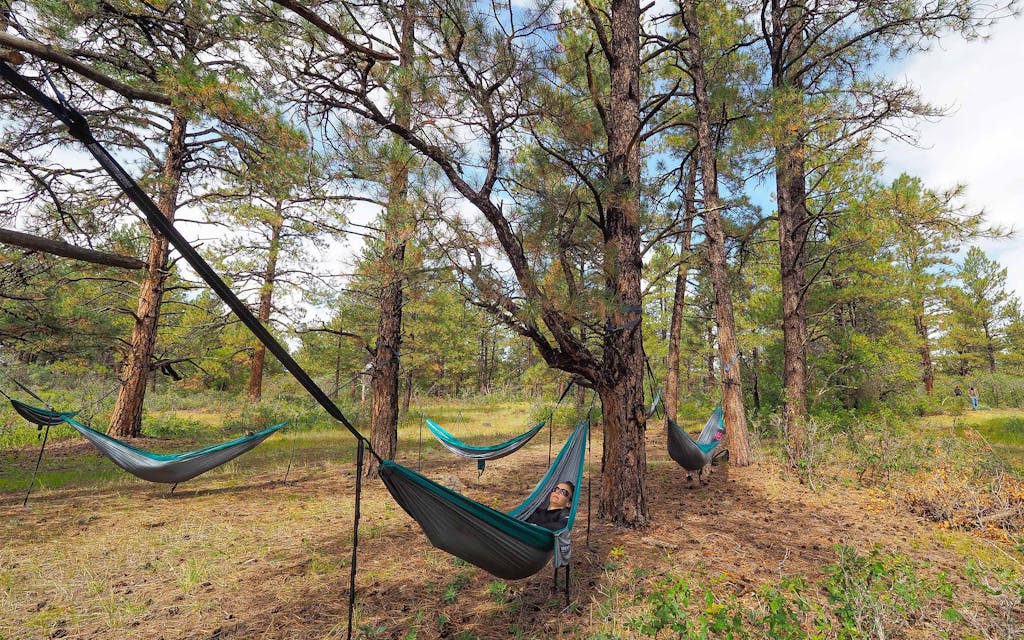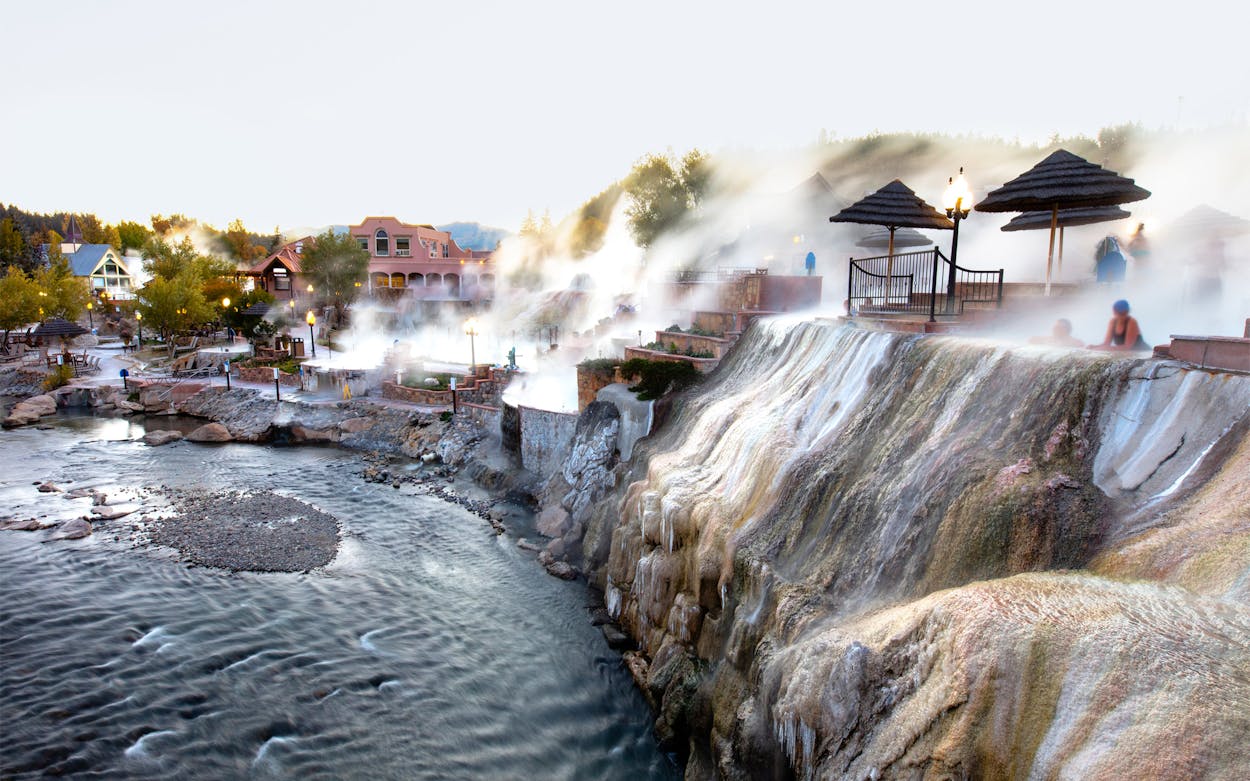On a hillside along the San Juan River in Pagosa Springs, Colorado, dozens of bathers relax in cement-walled tubs of steaming mineral water. Some lie back, eyes closed, faces flush and pink, their legs floating in front of them like pontoons. A few look like serene alligators, fully submerged except for their faces. Still others perch on the tubs’ edges, steam rising off their skin.
The water that fills the pools at the Springs Resort burbles forth from a deep geothermal aquifer called the Mother Spring, located higher up the hill. Members of the Ute tribe long flocked there, seeking its tranquil, pungent waters. Then, 150 years ago, settlers found it. This unusual spot is the world’s deepest known geothermal spring; a hydrologist and a Guinness World Records judge measuring it in 2011 ran out of plumb line at 1,002 feet.
Today, the springs’ hot water heats sidewalks and dome-shaped greenhouses along the river in Pagosa Springs, a little town of about 1,600 people in southwestern Colorado, roughly thirty miles from the New Mexico border. A local brewery, Riff Raff Brewing Company, even uses the water to brew what it calls “earth powered” beer. But the 25 soaking pools at the Springs Resort, owned by two Texans, are the main draw.
“This is where the magic happens,” says Jesse Hensle, director of marketing and sales at the resort, as a cloud of steam billowing from the Mother Spring partially obscures him from view.
This nearly seventy-year-old resort was looking a little dated when David Dronet and Charles Leddy bought the property in 2018. Changing rooms were dingy, and although guests could grab food at a snack bar, there was no sit-down restaurant. Dronet and Leddy’s team has spent four years sprucing up the place. They’ve renovated rooms, added a cafe, upgraded the plumbing system, remodeled the bathhouse, and otherwise worked to transition the property from a casual soaking spot into a wellness destination. Like so many Texans, Dronet (the New Braunfels–based managing partner of Olympus Real Estate Group) and Leddy (the San Antonio–based CEO of Presidian Hotels & Resorts) fell in love with Colorado on summer vacations to escape the heat in their home state.
“I remember driving across New Mexico and seeing the mountains rise up in front of me,” says Dronet, a mountain climber who has scaled Denali and Mount Rainier, of his first visit to the area sixteen years ago. “It struck me.” At first, he wondered why anyone would soak in hot water in the summer. But when he dipped a toe in that winter, he was swiftly converted.
In addition to buying the property, he and Leddy also purchased more land. In February, crews will break ground on an expansion that will double the size of the resort. There will soon be 21 additional riverfront pools tucked into secluded nooks and alcoves, a separate couples-only tub, 78 more guest rooms, a new restaurant, an outdoor music venue, and a geothermal spa with thirteen treatment rooms and three more soaking tubs.
Both men say they’ve experienced how soaking in highly mineralized hot water can improve muscle recovery, reduce inflammation, and even lead to deeper sleep. “There is no pharmaceutical that can do all the things that you get from a twenty-minute soak in hot mineral water,” says Marcus Coplin, a licensed naturopathic doctor and the resort’s medical director. While skeptics might debate the veracity of some of the myriad health benefits touted by mineral-water devotees, one thing is clear: a peaceful soak is very good for your mental health. A few hours of after-dinner soaking turned me into a blissed-out, sleepy noodle—I’ve never slept so well. You can even indulge in some midnight bathing under the stars, since the pools are open around the clock to overnight guests.
Stopping by just for the day is a great option too, with day passes available for $59 for adults and $30 for kids. Visitors can dip a toe in 25 different tubs, each with its own shape and personality. The Lobster Pot usually hovers around 112 degrees, so no one stays in long. Top o’ the Mornin’ and Clouds in My Coffee offer gorgeous views, while Aspen is more secluded.
If you can linger for a few days, you might unwind with a morning aqua yoga class or an evening balancing sound bath, in which an instructor gently taps Tibetan singing bowls and you just try to stay awake. Or try contrast bathing: alternating between warm water, hot water, and an ice-cold dip in the river. It’s fun to watch determined bathers emerge from the soaking pools, gingerly make their way to the river bank, then plunge into the chilly stream in a chorus of shrieks and shivers.
Once you’ve had enough of the springs, venture out to explore the rest of the Pagosa Springs area. This part of southwestern Colorado is still relatively uncrowded. The region is known for excellent hiking and mountain biking, as well as a rich cultural heritage. Mesa Verde National Park, with its ancient cliff dwellings, is a two-hour drive to the west. We’ve rounded up a few of our favorite activities below.

See + Do
For a bird’s-eye view of the valley, catch a ride in a wicker basket dangling beneath a hot-air balloon with Rocky Mountain Balloon Adventures. Houses, cars, and people shrink beneath you as the red, yellow, and blue balloon floats away with the prevailing winds. Chase vehicles follow from below, then return you to the company’s headquarters for a champagne (or juice) toast and a recitation of the Balloonist’s Prayer.
At Chimney Rock National Monument, twenty miles southwest of Pagosa Springs, hikers can explore more than two hundred structures, including kivas, pit houses, and large buildings called great houses, built by ancestral Puebloans. But the biggest draws are the two rocky spires that rise from the top of a mesa. Visit at the right time (during a recurring phenomenon known as a major lunar standstill), and you can watch the moon rise between those pillars in a brief, stunning display. It will happen starting this December. Though the park will be closed (it’s open from May 15 through September 30), you can check the website, where rangers plan to announce special dates for the moonrise viewings.
In the winter, Pagosa Springs serves as a home base for skiers who head to Wolf Creek Ski Area, a no-frills, retro-vibed getaway with challenging slopes. Wolf Creek’s slogan is “The Most Snow in Colorado,” after its plentiful powder—it holds the state’s all-time annual record of 837.5 inches.
Dine + Drink
Kip’s Grill started as a grab-and-go eatery in an old train caboose on the side of a highway in Del Norte, Colorado. Today the Pagosa Springs location draws big crowds that come for street tacos (try the spicy shrimp), green chile cheeseburgers, and margaritas. For a more upscale meal, head to Alley House Grille, which serves braised lamb shank, Chilean sea bass, grilled elk, and bison inside a cottage built in 1912.
At the recently reopened Ole Miner’s Steak & Chophouse, you’ll feel like you’ve stepped inside an old miner’s cabin, complete with big timbers, barnwood, and light fixtures salvaged from former train cars. The menu ranges from ribeye to duck and includes vegetarian options.
Shop
Root House, tucked in an alley along the river, is part coffeehouse, part cocktail bar, part bakery, and part eclectic shop. Browse locally crafted leather bags, cutting boards, coffee beans, soap, clothing, and jewelry. A few steps away, at Two Old Crows Gallery, admire paintings, furniture, ceramics, photography, glasswork, and home decor.
Stay
The Springs Resort isn’t the only place in town with easy access to mineral hot springs. For a more basic experience, try RiverWalk Inn or Healing Waters Resort & Spa. The recently renovated RiverWalk is on a pathway that hugs the San Juan River in downtown Pagosa Springs; Healing Waters offers cozy cabins near indoor and outdoor tubs and baths. Four miles west of downtown, Club Wyndham Pagosa offers rental condos on 18,000 acres around Pinon Lake Reservoir, with access to golfing and tennis, plus a slate of other family-friendly activities.
- More About:
- Water






